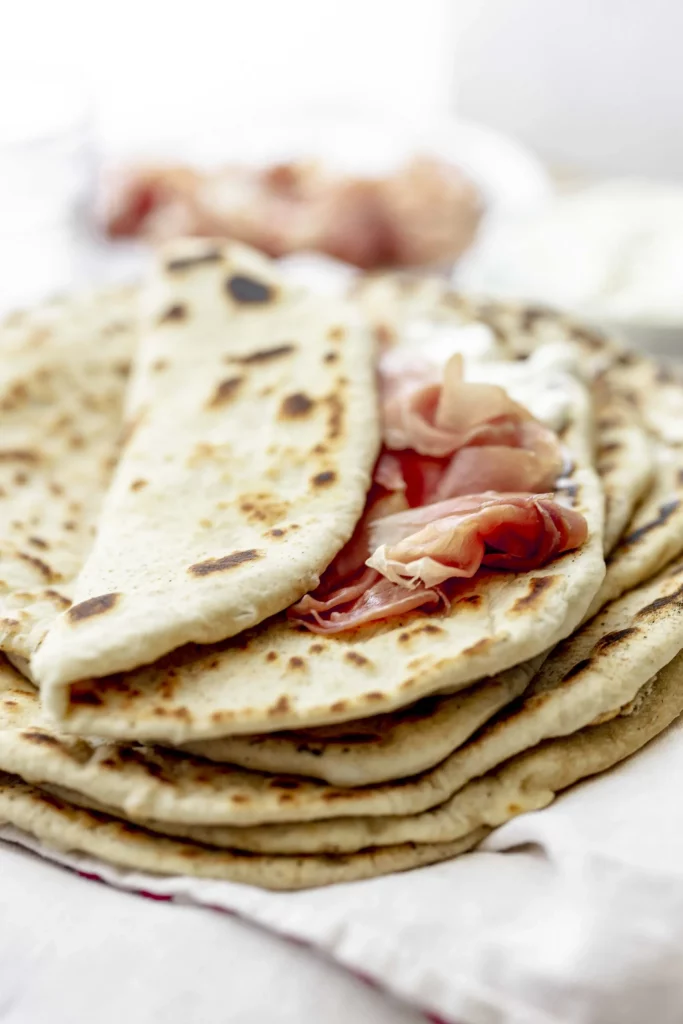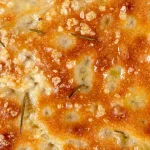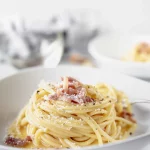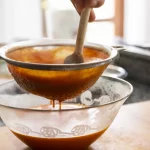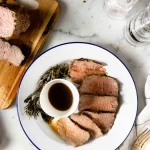Piadina is not just any kind of food; it is famous because it represents the history of an entire region with very deep-rooted traditions.
Making piadina is much more than baking some bread to fill assorted fillings; it is a kind of magic! You must make piadina on your own the recipe is easy and so much better than any store-bought flatbreads. Give it a try and let me know what you think.
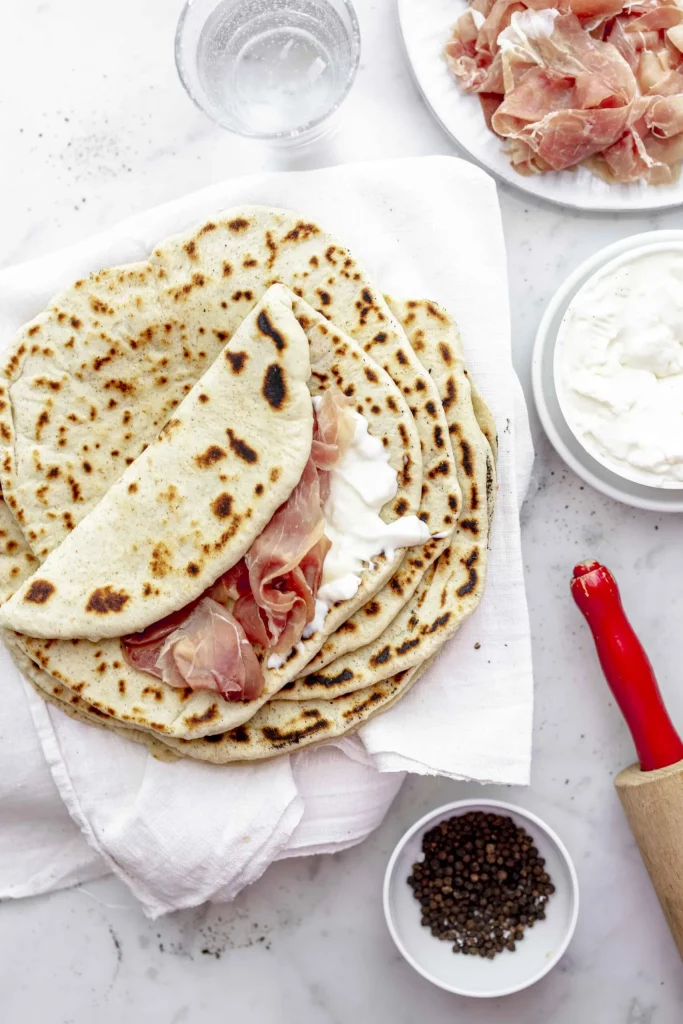
Where is piadina from?
Piadina originated in Romagna, part of the wonderful region of Emilia-Romagna, where I spent my childhood. With summers at the sea, along with all of my memories from those amazing years, what I remember most was the piadina, which made the perfect snack that satisfied my hunger after hours of swimming in the sea.
Piadina was created many years ago with its poor and humble beginnings. Made from wheat flour, water, and a little yeast, it was then kneaded and cooked on a stone surface. Easy to bake and very adaptable, piadina from Romagna was the most common food for the peasants and all the poor people who survived on their homegrown produce. Nowadays, piadina has become a gourmet dish.
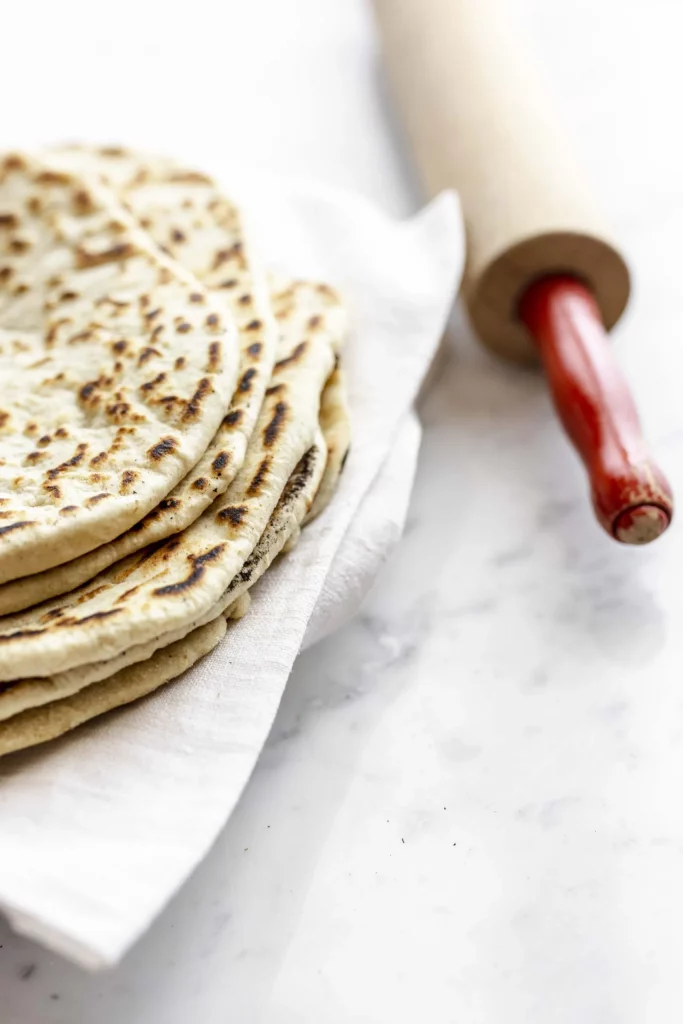
Where can you find it?
You will encounter piadina everywhere in Emilia-Romagna. Just look for tiny kiosks, or piadinari, with red and white-striped walls that line the streets. You can’t miss these family-run kiosks because there is always a long line of people who are waiting for their freshly made, mouthwatering piadina.
Nowadays, piadina has spread throughout the world because as soon as you taste it, you will crave more. You can even eat it standing, but the best part is catching the filling as it spills out onto your hands. That’s the most scrumptious part!
There are many words to describe similar food
You might come across different words for the same food: piada, piadina, crescione or cassone. They have a few differences, but they start with the same flatbread base: crescione is stuffed, folded, closed, and then baked; whereas piada or piadina is cooked first and then stuffed with cured meat or cheese and vegetables and then rolled up and eaten. They are absolutely mouthwatering!
What is a piadina sandwich?
Piadina is a thin, light, flat bread made from flour, water, and lard or extra virgin olive oil and then kneaded and cooked on a griddle. After it is filled with whatever you like and rolled like a burrito. You will encounter two kinds of piadina in Emilia-Romagna: the one from Romagna is more compact, crumbly, and stiff. The other piadina from Rimini is thin, soft, and fluffy.
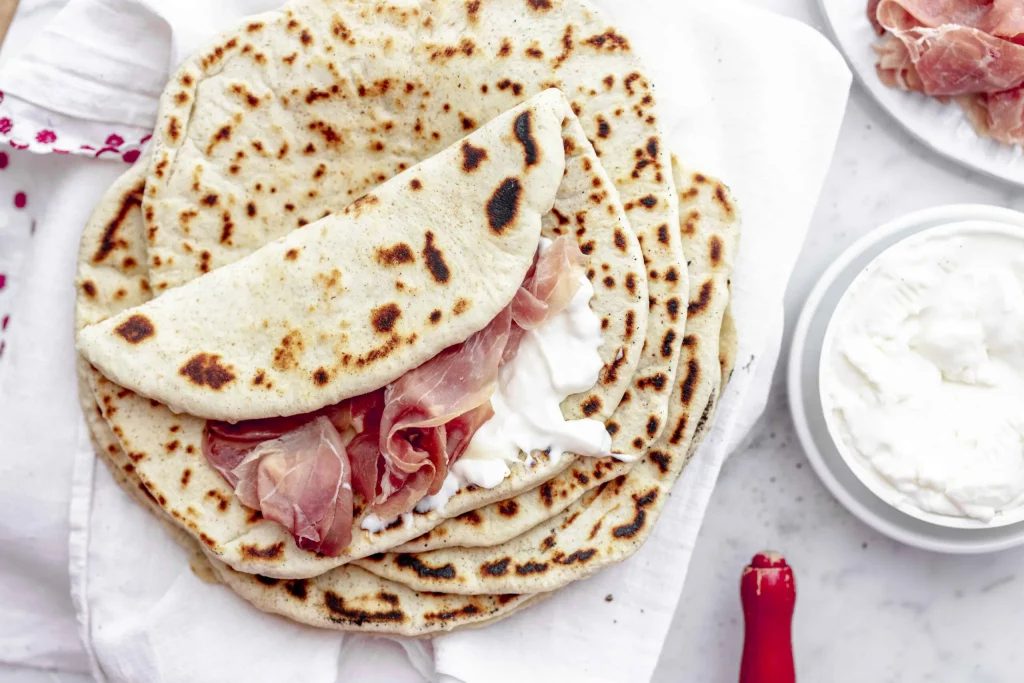
How do you eat piadina?
According to the most genuine of recipes from Romagna, Parma ham, arugula, and squacquerone, or spreadable fresh cheese, make the perfect combination of tastes: savory and delicate ham, bitter greens, and creamy, melt-in-your-mouth cheese. This is what you have to experience if you have never tasted piadina before.
Of course, you may encounter thousands of variations, which suit a fast lunch break or an informal picnic dinner with friends and family. Stuff it to your liking—the wide range of combinations make piadina a treat you won’t get tired of. There are even versions of sweet piadina, which make a mouthwatering dessert or an irresistible snack for children and adults alike.
The most important ingredients:
- All-purpose flour with a varying quantity of water. Water absorption does not only depend on the type of flour used but also on the weather conditions. On hot days, less yeast and water are needed than on cold ones. A little practice will help you to “feel” when the dough has reached the right consistency. It should be smooth and tacky but not sticky. In case it is too sticky, add some more flour;
- Water: use tap water. The quantity depends on the type of flour and the weather conditions but most of all on the humidity;
- Milk: it makes the dough light and is the secret to making the piadina even more delicious;
- Leavening agent: piadina doesn’t call for any yeast. In the past, the tip of a teaspoon of baking soda used to be added for an airier and softer dough. Nowadays, baking soda is sometimes replaced with 2 teaspoons of instant yeast. Anyway, piadina turns out fine without any leavening agents;
- Fat: use lard or extra virgin olive oil. If you want a lighter variation, use sunflower or peanut oil. Lard makes your piadina as appetizing as those you may get in a kiosk in Romagna!
The key points of the recipe:
- Resting time: wrap the dough in plastic wrap for about 2-3 hours. The resting time makes the dough tastier and easier to roll;
- Piadina is done when leopard-like spots appear on both sides. Quickly remove it from the pan; fill it with goodies and fold it over like a burrito. Eat warm!
Piadina romagnola – How to make a super tasty flatbread sandwich
Ingredients
- 2.2 lbs of all-purpose flour (1 kg)
- ¾ cup + 2 tablespoons (200g) of lard or ¾ cup + 2 tablespoons (190g) of extra virgin olive oil
- ¾ tsp of baking soda (5g)
- about 1¼ cups + 2 tablespoons (400ml) of water
- 3.5 tsp of salt (20g)
- Extra: 3-4 tablespoons of milk (or 250ml of milk + 150ml of water for a more fragrant piadina
- Extra: 1 teaspoon of honey gives piadina a nice golden color.
Instructions
- Sift the flour onto a wooden board (you may use the stand mixer, or KitchenAid, fitted with a dough hook); then sift in the salt and baking soda;
- Add room-temperature lard or oil. Smash the lard with the tips of your fingers and combine it with the flour until it is completely incorporated;
- Mix with a fork while taking a little flour from the sides each time; then add the water in gradually. Start mixing with your hands until the dough comes together. Add more flour if the dough is sticky;
- Knead the dough vigorously until it’s smooth and elastic;
- Divide the dough into 8-10 even balls; they should be as big as a tangerine;
- Place the balls to rest for at least 2 hours (you may use the dough without letting it rest, but it will be less tasty);
- After the resting period, flour the pastry board, and on a smooth surface (a marble surface is perfect), roll the ball into a disc roughly 8-10 inches (20-25cm) in diameter and very thin (2mm). Try to make them as round as possible: always keep the rolling pin in the same position while you are rolling the ball. Rotate the dough at a right angle instead.
- If the piadina sticks to the rolling pin, sprinkle the surface with a little flour;
- Heat a griddle or a non-stick pan; cook the piadina over medium heat;
- Gently prick the surface to avoid bubbles;
- It takes a few minutes; cook the piadina a couple of minutes on each side or until it’s golden; use a spatula to flip it over. The piadina is done when it shows leopard-like spots.
- Add your favorite fillings. Below are a few suggestions.
What can I fill piadina with?
Piadina must be eaten freshly made and hot in order to enjoy its full flavor. Slice and sprinkle it with a little oil and chopped rosemary, which will become a finger-licking appetizer. What about having it instead of bread? Below you may find the most delectable combinations of ingredients to fill piadina with. Make sure to load them generously:
Suggestions:
- Parma ham, soft and creamy cheese (stracchino or squaquerone), and arugula or lettuce;
- Mortadella with cream cheese and coarsely chopped pistachios;
- Speck, brie, and mushrooms;
- Ham, asparagus, and soft cheese;
- Mozzarella, tomatoes, fresh basil, or oregano;
- Mixed grilled veggies, mozzarella or cream cheese, and oregano;
- Parma ham, lettuce, tomatoes, and mozzarella;
- Smoked salmon, cream cheese, and avocado;
- Tuna, artichokes, and arugula;
- Parma ham, artichokes, and arugula;
- Roasted turkey breast, mayo, lettuce;
- Tuna, tomatoes, lettuce, mayo;
- And the sweet treats: Nutella, Nutella, and more Nutella, the best-known chocolate hazelnut spread in Italy and coarsely chopped hazelnuts. In the US, you could stuff it with peanut butter and chocolate chips. This would definitely be scrumptious.

How can you store piadina?
Cooked piadina discs keep fresh in the fridge in an airtight container for up to 2 days. You may freeze them too; cook the discs briefly (about one minute each side), divide them with sheets of parchment paper between them, wrap them up, and put them in the freezer. When you want one, you won’t have to defrost it. Just place the frozen dough disc onto a very hot pan and cook it until done. It will be just as scrumptious as a fresh one.

